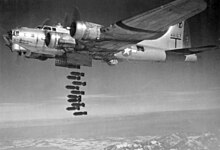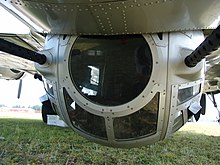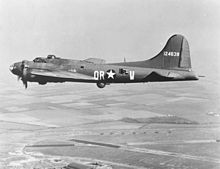Boeing B-17
| Boeing B-17 Flying Fortress | |
|---|---|
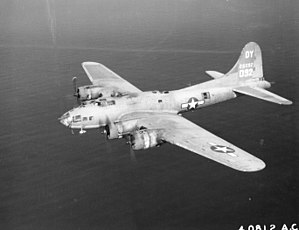 USAAF Boeing B-17F "Flying Fortress" |
|
| Type: | bomber |
| Design country: | |
| Manufacturer: | |
| First flight: |
July 28, 1935 |
| Commissioning: |
April 1938 |
| Production time: |
1936 to 1945 |
| Number of pieces: |
12,731 |
The Boeing B-17 Flying Fortress ( English for Flying Fortress ) is a heavy bomber / horizontal bomber of the Boeing Airplane Company . It is the most famous bomber used by the US Air Force during World War II and was known for being able to fly despite severe damage. The full crew of a Flying Fortress consisted of ten men; four of them were exclusively machine gunner.
A total of 12,731 machines were produced, the unit price about 250,000 US dollars was. Based on the year 1943, including inflation , this corresponds to a current value of 3,690,000 US dollars each. The letter "B" in the name stands for bomber.
history

The Boeing Model 299 prototype was developed on the basis of a tender for a land-based bomber for long-haul operations over the sea. The prototype with the civil aircraft registration number X-13372 flew for the first time on July 28, 1935. Due to a pilot's mistake, the machine was lost in a crash. After adjustments to the needs of the US Air Force - modified nose, larger vertical tail, improved interior equipment - the new prototype Y1B-17 took off on its maiden flight in January 1937 . Finally, the first B-17B series aircraft was delivered to the United States Army Air Corps (USAAC) on October 20, 1939 . Four served as a driving Wright R-1820-51 - radial engines with 1000 hp (745.7 kW). 38 more machines followed.
On July 21, 1940, the first flight of the B-17C took place, which received armor and self-sealing tanks in addition to reinforced defensive armament . In addition, the installation of cyclone engines increased the engine output to 1200 hp (894.8 kW) each. 20 of these machines went as Fortress Mk I to the RAF .
Another 42 were ordered by the USAAC and later converted to the B-17D .
With the B-17E in 1941 the arms behind the cockpit and under the fuselage as well as the rear stand were added, the caliber of the MG was now uniformly .50 Browning ( .50 BMG ); they received the larger and further drawn tail unit, which later became the characteristic feature of the B-17. The range of the B-17E was 5300 km without bombs; the bomb load was - compared to later versions - a relatively low 2000 kg. 512 B-17E and 45 Fortress II were delivered to the 8th Air Force and the RAF, respectively.
A year later, the B-17F followed with a new bow pulpit made of Plexiglas and a range of 7110 km (without bombs). This machine, of which 3,405 examples - including 61 Fortress IIs for the RAF - were built, could already carry 4,700 kg of bombs. 61 aircraft were converted into F-9 photo reconnaissance aircraft .
On May 21, 1943, the first flight of the last production version - the B-17G . Under the bow it had an additional weapon turret with a twin machine-gun, as well as mutually offset weapon stands in the bow space and fuselage, in order to avoid mutual obstruction of the machine-gunner. The model was built a total of 8,680 times by mid-1945. 85 aircraft went to the RAF, 10 more were converted to F-9C photo reconnaissance, 40 aircraft were delivered to the US Navy as PB-1G or PB-1W , the latter with radar pan, for anti-submarine defense, and 130 more as B. -17H sea rescue planes with lifeboat attached under the hull. Many B-17s of the F series have been converted to the G version and upgraded.
A total of 12,731 B-17 machines have been produced by Boeing and the licensees Douglas and Lockheed - at peak times there were 16 machines a day. An important plant was Boeing Plant 2 south of Seattle .
The sections of the plane
The fuselage of a B-17 can be roughly divided into three sections - explained below lengthwise from the stern .
Tail section with tail and hull weapon stands
In the outermost tail of the aircraft fuselage is the position of the tail gunner ( English Tail Gunner , nickname "Tail-end Charlie" - in German roughly "tail pig"). In this extremely narrow and uncomfortable cockpit, the shooter sat behind a Browning M2 twin machine gun .50 BMG caliber (12.7 × 99 mm). It was the most dangerous position on the plane as bomber formations were often attacked from below by fighter planes.
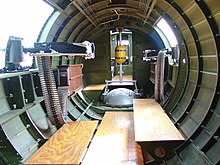
Further towards the middle of the torso are the positions of the side gunners (waist gunners) on the right and left . Each of the two shooters operated a machine gun mounted on a mount , which fired from a side window - open up to the production version "F" and closed with a plexiglass pane from version "G" - and thus secured the aircraft to the sides.
Middle fuselage section with weapon tower, radio room and bomb bay
To secure the airspace in all horizontal directions and downwards, the spherical Sperry Browning MG tower is embedded in the fuselage floor closer to the bow . It can be rotated around its horizontal and vertical axis by an electric motor and is also equipped with a twin MG. Since the space in the spherical tower is very cramped, mainly small men were used here. The Ball Turret Gunner was lying on his back, looking out of several small windows out of the tower and aiming between his legs. He also had the task of confirming the opening and closing of the bomb bay and the bombing. This position was also particularly dangerous during operations: Even with outside help, the shooter needed about a minute to leave the tower - in a falling B-17 there was usually not enough time to free the shooter from his prison. In addition, due to the limited space, the turret gunner could not carry a parachute and was only secured with a snap hook on a belt that was attached to the support structure of the dome.
The radio operator's room was adjacent to the bow . Early series there were equipped with a single machine gun mounted in the ceiling window on a mount and pointing towards the rear, with which aircraft could be fired in the airspace behind and above the bomber. In practice it was seldom used because it was difficult to operate and the radio operator was usually busy enough with his main tasks anyway. At the latest from the "G" series onwards, this MG was not installed in order to save weight.
The radio room is separated from the bomb bay further forward by a passage . Here there is a catwalk in the middle and to the right and left of it the mounts for the bombs . Below the catwalk is the bomb bay hatch, the downward-opening flaps of which were opened by the bombardier shortly before the bomb was dropped. Most of the oxygen bottles for the crew's breathing apparatus were installed in this area.
Bow section with upper turret, cockpit and bow room

Another passage leads into the cockpit . On a platform in the rear part was the place of the technician, who also acted as the shooter of the upper machine gun turret (Top Turret Gunner) . It was supposed to fix any technical problems and also to secure the airspace above the aircraft in the rotating upper tower, which was also equipped with a twin machine gun.
In the cockpit itself are the seats for the pilot and the copilot. The view from these seats is restricted by the long bow of the aircraft, so that the cockpit crew only had an unobstructed view straight ahead and to the sides. The pilots were particularly dependent on the help of the crew members in the bow space during take-offs and landings.
A hatch in the footwell between the pilots leads to the lower bow space. Here there is a map table for the navigator and in the plexiglass front pulpit the swivel chair of the bombardier. During the target approach during operations, the bombardier operated the Norden bomb sighting device mounted in the pulpit to locate the target as precisely as possible, the hatches of the bomb bay and the trigger for dropping the bomb load. However, the bomb sight was only used in the command aircraft of a squadron; the bombardiers of all other aircraft dropped their bombs at the same time as that of the pilot aircraft. During the rest of the missions, the bombardier in machines from the "G" series as " Chin Turret Gunner " operated the electrically operated front gun turret, also equipped with a twin machine gun. The navigator had the machine guns at his disposal (nose gunner) mounted in the side windows of the bow space .
The B-17 crew - duties and equipment

The crew members and their duties
- Pilot - left in the cockpit
- Copilot - right in the cockpit
- Bombardier - in the bow area, from series G also chin turret gunner, previously bow gunner
- Navigator - in the bow space, at the same time nose gun (one machine gun left and right in the bow space)
- Technician - behind the cockpit, at the same time the tower gunner
- Radio operator - in all series up to the G model, roof contactors at the same time
- Turret shooter
- Gunner on the right
- Gunner on the left
- Rear gunner
Protective clothing
Due to the partially open armaments, the crew members required special equipment in order to be able to defy the climatic conditions prevailing at high altitudes. Everyone wore electrically heated overalls over a woolen undergarment. Then followed the uniform, over which a sheepskin- lined aviator suit was pulled, including the legendary bomber jacket of the United States Army Air Forces (USAAF) , model "B-3". In addition, a chest and back armor was worn, which consisted of a dense chain mail that reached from the neck to the pelvis and was intended to protect against flak fragments and machine-gun bullets. The crews wore high sheepskin boots, bright yellow life jackets , parachutes and thick electrically heated gloves. The head was protected by a warm hat and, if necessary, a steel flak helmet . With such clothing, the crew members could hardly move, which is why the heavy protective clothing in particular was only put on by many crews during deployment phases under threat of flak fire and then taken off again.
Gloves had to be removed when performing activities such as first aid and repairs to the devices. Every second counted here, as the temperature in the unheated fuselage of the aircraft was well below freezing at high altitudes . Frostbite was common and it was not uncommon for crew members to lose fingers.
Devices and armament
Each crew member wore an oxygen mask at great heights , as well as headphones and a larynx microphone for the on-board intercom. In addition to the pilot and the copilot (and, from parts of the G series, the radio operator), each of the ten crew members operated at least one heavy Browning machine gun to defend the bomber against attacking fighter planes .
Armor protection B-17F
The armor protection of a B-17F (status at the end of 1943) consisted of several 6.3 to 8.0 mm thick armor plates, almost all of which were installed vertically in the aircraft - similar to bulkheads in a ship's hull. Armor plates were only installed at the level of the two lateral fuselage gunners, which should also protect against lateral fire. Although the backrests of the commander's and copilot's seats were armored, there was no armored plate protection that could have protected the pilots from frontal fire. Neither the navigator nor the bombardier had armor plate protection acting forward. All armor plates had a strength of 1000 to 1500 N / mm 2 , with the bullet side being hardened to a depth of 2 mm with a strength of 2000 to 2500 N / mm 2 . The total weight of all armor plates in an aircraft was 331.5 kg. In relation to the total weight of an unloaded B-17 (16,000 kg), the weight share of all armor plates was about 2 percent of the total weight.
B-17F ammunition carried
A B-17 F carried 5,630 cartridges, distributed among the various armaments, and a further 1,855 cartridges in seven reserve boxes - a total of 7,485 cartridges. The total weight of the cartridge ammunition carried was around 1000 kg.
Use in the British Air Force
The Royal Air Force (RAF) signed an agreement with the US Army Air Corps in early 1940 to purchase 20 B-17Cs. Their first use took place on July 8, 1941 against Wilhelmshaven and was unsuccessful. On July 24, three B-17s took part in an attack on the German battleships Gneisenau and Prinz Eugen anchored in Brest from a height of 9,100 m, with the aim of distracting the German fighters from 18 Handley Page Hampdens and 79 Vickers Wellingtons. The operation did not work as expected as the B-17s were not attacked. By September, the RAF had lost eight B-17Cs in combat and had numerous mechanical problems. The Bomber Command was bombing in daylight using the B-17 because of the poor performance of the aircraft. The operational experience showed both the RAF and the USAAF that the B-17C was not combat ready and that improved defensive armament, larger bomb loads and more precise bombing methods were required. The USAAF used the B-17 as a daytime bomber, however, despite the RAF's concerns that attempts to bomb in daylight would be ineffective.
Since the use by the Bomber Command had been restricted, the RAF transferred its remaining aircraft to the Coastal Command for use as a long-range sea patrol aircraft . From July 1942, these were expanded to include 45 B-17E, followed by 19 B-17F and three B-17G. A B-17 of the No. 206 squadron of the RAF sank U-627 on October 27, 1942, the first of 11 submarine sinkings attributed to the RAF-B-17 during the war. When finally enough Consolidated Liberators were available, the Coastal Command withdrew the B-17 from the Azores and transferred the B-17 to the role of meteorological reconnaissance. Three squadrons took over weather observation flights from airfields in Iceland, Scotland and England and collected data for important weather forecasts.
The RAF No. 223 Squadron operated a number of B-17s equipped with an electronic warfare system called the Airborne Cigar (ABC). This was operated by German-speaking radio operators who were supposed to identify and disrupt the transmissions of the German ground control officers for their night fighters. They could also pretend to be ground controllers, with the intention of distracting the night fighters from the stream of bombers.
Significant stakes

The B-17 together with the B-24 "Liberator" formed the backbone of the US bomber units in Europe during World War II. The first B-17 formations of the 8th Air Force landed in England on May 12, 1942. They initially flew without escort, later escorted by P-51 Mustang , P-47 Thunderbolt and other fighter aircraft, especially during daytime raids on the Reich and the occupied territories. The following missions became particularly well-known:
- August 17, 1942: First day raid by 8th Air Force B-17 on Rouen .
- July 24 to August 3, 1943: Participation in Operation Gomorrah . Day attacks by the 8th Air Force with up to 120 aircraft on Hamburg (alternating with night attacks by the Royal Air Force ).
- August 17, 1943: Attack on the Messerschmitt works in Regensburg and the ball bearing industry in Schweinfurt with a total of 376 machines, 60 of which were shot down and over 100 were damaged (see also Operation Double Strike ).
- February 20-25, 1944: Big Week - Several hundred B-17s bombed German aircraft factories.
- 5 April to 17 October 1944. After the largely unsuccessful Operation Tidal Wave from the previous year (performed exclusively by B-24 from North Africa) were from Italy again strategic air raids on Ploiesti up more than 600 B-17 of the 15th Air Force on flown the oil fields and petroleum production facilities in Romania as well as the traffic and transport centers of the Wehrmacht in the Balkans in Niš and Belgrade .
- July 26, 1944: The 15th Air Force attacked airfields and aircraft factories in eastern Austria with more than 300 bombers. Due to a communication error, the last flight to fly in, the 301st Bombardment Group, was on the move for a short time without escort by its own fighter aircraft. Pilots from German Fighter Squadrons 300 and 302 used this time to shoot down eleven B-17s over Styria and southern Lower Austria within a few minutes . The breakdown cost the lives of 66 Americans, and another 43 were taken prisoners of war.
- February 3, 1945: One of the heaviest Allied air raids on Berlin with 937 B-17s.
Use in the German Air Force
Some B-17s had to make an emergency landing on territory occupied by Germany and were used by the German Air Force after the repair under the camouflage designation " Do 200 " for the "Kampfgeschwader 200" for special operations.
Versions
- Boeing Model 299
- Prototype with four 750 hp Pratt & Whitney R-1690, 1 engines was built.
- YB-17 (Y1B-17)
- Pre-production aircraft with four 930 hp Wright R-1820-39 Cyclone engines, 13 were built.
- B-17A (Y1B-17A)
- Prototype with four 1000 hp Wright R-1820-51 turbocharged engines, 1 was built.
- B-17B
- Series version with enlarged tail unit, larger landing flaps and new plexiglass nose, 39 built.
- B-17C
- B-17C with 1200 hp Wright R-1820-65 engines. The bulging side stands were replaced by flat windows, the lower body MG was integrated into a floor pan. 38 aircraft were built, 20 were sold to Great Britain as Fortress Mk I in 1941 .
- B-17D
- Improved B-17C with self-sealing tanks, improved armor and new electrics, 42 were built. The remaining B-17C were later upgraded to the B-17D standard.
- B-17E
- Greatly improved version with new armament: rear combat stand with two 12.7 mm machine guns in the new aircraft tail, machine gun turret with two 12.7 mm machine guns on and under the fuselage, rectangular side windows with one 12.7 mm each -MG. 512 were built, 45 B-17E were delivered to the RAF as Fortress Mk IIA .
- B-17F
- B-17E with 1200 hp Wright R-1820-97 engines and additional MG in the bow. 3405 were built, 2300 by Boeing, 605 by Douglas and 500 by Lockheed. 19 B-17Fs were delivered to the RAF as Fortress Mk II .
- B-17G
- Improved B-17F with a 12.7 mm machine gun turret under the aircraft nose. 8,680 were built, of which 4,035 at Boeing in Seattle and Wichita , 2,395 machines at Douglas in Tulsa and 2,250 machines at Lockheed in Burbank . 85 B-17G were delivered to the RAF as Fortress Mk III .
- CB-17G
- B-17G converted into transport aircraft for 64 soldiers.
- DB-17G
- B-17G converted to a drone director.
- JB-17G
- B-17G converted into a test aircraft.
- RB-17G
- B-17G converted into reconnaissance aircraft.
- SB-17G
- B-17G (originally B-17H) converted into rescue aircraft with a dropping A-1 lifeboat under the fuselage.
- TB-17G
- B-17G converted into training aircraft.
- VB-17G
- B-17G converted into a VIP transporter.
- QB-17L
- B-17G converted to a drone.
- QB-17N
- B-17G converted to a drone.
- XB-38
- Conversion of a B-17E with V-engines Allison V-1710-89 .
- XB-40
- B-17F escort bomber with additional rear turret, bow turret and side machine gun as well as machine gun ammunition magazine in the bomb bay. 26 were built, 1 prototype XB-40, 21 pre-production aircraft YB-40 and 4 training aircraft TB-40.
- C-108
- B-17G as VIP transporter, 4 were built (similar to CB / VB-17G).
- F-9
- Conversion of 17 B-17F to reconnaissance aircraft.
- F-9A
- Conversion of 17 B-17F to reconnaissance aircraft (different camera equipment).
- F-9C
- Conversion of 17 B-17G to reconnaissance aircraft, from 1948 RB-17G .
- BQ-7 Aphrodite
- Conversion of at least 25 B-17Gs into missiles (flying bomb with 9070 kg Torpex explosives).
- PB-1
- Designation of the United States Navy for one B-17F and one B-17G that were used as test aircraft.
- PB-1G
- Conversion of 17 B-17Gs analogous to the SB-17G for the United States Coast Guard .
- PB-1W
- Conversion of 31 B-17G and equipment with APS-20 air surveillance radar under the fuselage and radar control personnel ( Airborne Early Warning ).
production
Approval of the B-17 by the USAAF:
| Manufacturer | version | before 1940 | 1940 | 1941 | 1942 | 1943 | 1944 | 1945 | TOTAL |
|---|---|---|---|---|---|---|---|---|---|
| Boeing, Seattle | XB-17 | 1 | 1 | ||||||
| Boeing, Seattle | Y1B-17 | 13 | 13 | ||||||
| Boeing, Seattle | Y1B-17A | 1 | 1 | ||||||
| Boeing, Seattle | B-17B | 24 | 15th | 39 | |||||
| Boeing, Seattle | B-17C | 38 | 38 | ||||||
| Boeing, Seattle | B-17D | 42 | 42 | ||||||
| Boeing, Seattle | B-17E | 102 | 410 | 512 | |||||
| Boeing, Seattle | B-17F | 849 | 1,451 | 2,300 | |||||
| Douglas, Long Beach | B-17F | 85 | 520 | 605 | |||||
| Lockheed, Burbank | B-17F | 68 | 432 | 500 | |||||
| Boeing, Seattle | B-17G | 889 | 2,837 | 309 | 4,035 | ||||
| Douglas, Long Beach | B-17G | 432 | 1,271 | 692 | 2,395 | ||||
| Lockheed, Burbank | B-17G | 455 | 1,244 | 551 | 2,250 | ||||
| TOTAL | 39 | 53 | 144 | 1,412 | 4.179 | 5,352 | 1,552 | 12,731 |
Military users
-
 Argentina
Argentina
-
 Bolivia
Bolivia
-
 Brazil : 13
Brazil : 13 -
 Denmark
Denmark
-
 German Empire : about 40 captured aircraft
German Empire : about 40 captured aircraft -
 Dominican Republic : 2
Dominican Republic : 2 -
 France
France
-
 Iran
Iran
-
 Israel : 3
Israel : 3 -
 Japan : some early-version machines captured in the Philippines and the Dutch East Indies
Japan : some early-version machines captured in the Philippines and the Dutch East Indies -
 Canada
Canada
-
 Colombia
Colombia
-
 Mexico
Mexico
-
 Nicaragua
Nicaragua
-
 Peru
Peru
-
 Portugal : 5 SB-17G for search and rescue from 1947 to 1960.
Portugal : 5 SB-17G for search and rescue from 1947 to 1960. -
 Taiwan
Taiwan
-
 Saudi Arabia
Saudi Arabia
-
 Soviet Union
Soviet Union
-
 South African Union
South African Union
-
 United States
United States
-
 United Kingdom
United Kingdom
Incidents involving civilian operated B-17s
- On January 30, 1946, the B-17G of Det Danske Luftfartselskab (DDL) ( aircraft registration number OY-DFE , formerly SE-BAR ) came off the runway on landing at Copenhagen Airport , sped into the apron and crashed into a parked Douglas DC-3 (KG427) of the Royal Air Force . Both machines were destroyed; there was no personal injury.
- On October 2, 2019, seven people died in an accident involving the machine called Nine-O-Nine . Six others were injured. According to eyewitness accounts, the plane struggled to gain altitude and returned. When attempting to land, the machine crashed on the grounds of Bradley International Airport in Windsor Locks .
Technical specifications
| Parameter | Data of the B-17G |
|---|---|
| length | 22.80 m |
| height | 5.85 m |
| Wingspan | 31.63 m |
| Wing area | 141.90 m² |
| Empty weight | 14,855 kg |
| Maximum takeoff weight | 29,700 kg |
| drive | four nine-cylinder Curtiss-Wright R-1820-97 Cyclone radial engines , each with 1,200 hp (894.8 kW) at 2,300 rpm |
| Top speed | 485 km / h |
| Marching speed | 296 km / h |
| Maximum range | 6,034 km without bombs |
| Range | 2,897 km with normal load, 1,760 km with maximum load |
| Service ceiling | 11,920 m |
| crew | min. six men, generally ten men |
Armament
- 13 Browning MG of caliber .50 BMG
- Twin machine guns in the front chin turret, front deck turret, middle pulpit and in the stern
- Single MG on the side bow windows, on the side windows and in the radio station on the back of the aircraft
- Up to 5800 kg bomb load (for short-range missions)
- 2724 kg standard load
- reduced to 2000 kg for more than 800 miles (approx. 1290 km) distance
present
There are currently over 40 aircraft preserved, some of which are airworthy. Most of these are owned by museums or private collectors.
The best known of the exhibited examples is the Memphis Belle . It was the first aircraft to return to the United States after 25 enemy flights over the European theater of war. After its celebrated return, it was parked in the open for a long time and then restored. It has been on display at the National Museum of the United States Air Force since 2018 .
Media reception
- The commander
- Memphis Belle
- James Bond 007 - fireball (as unmarked CIA rescue plane)
- Heavy Metal (Episode B-17)
- 1941 - Where are you going to Hollywood
literature
- Thunder in the Heavens - Classic US aircraft from World War II. Karl Müller Verlag, Erlangen 1995, ISBN 3-86070-364-1 .
- Steve Birdsall: Fighting Colors - B-17 Flying Fortress in Color. (English).
Squadron / Signal Publications, Carrollton (Texas) 1986, ISBN 0-89747-180-6 . - Larry Davis, Don Greer: B-17 in Action. (English) Squadron / Signal Publications, Carrollton (Texas) 1984, ISBN 0-89747-152-0 .
- Edward Jablonski: America in the Air War. Appeared in the Time-Life Books series
History of Aviation. Bechtermünz Verlag, Eltville am Rhein 1993, ISBN 3-86047-049-3 . - Friedrich König: The History of the Air Force. Rastatt 1980, p. 126.
- Ray T. Matheny: The Fire Riders - Trapped in Flying Fortresses. Albrecht Knaus Verlag, Munich 1987, ISBN 3-8135-0568-5 .
- Kenneth Munson: Bombers, Patrol and Transport Aircraft 1939–45. 3rd edition, Orell Füssli, Zurich 1977, ISBN 3-280-00326-1 .
Web links
- The Official Memphis Belle Web Site - Memphis Belle Memorial Association (English)
- B-17 Preservation Ltd - The Sally B Web Site
- Pilot's Flight Operating Instructions for Army Models B-17F and G British Model Fortress II. (PDF) In: FliegerRevueX. PPVMEDIEN GmbH, August 1, 1943, accessed on December 28, 2019 (English).
Individual evidence
- ↑ This figure was based on the template: Inflation determined, rounded to a full 10,000 and relates to the previous January.
- ^ Olaf Groehler : History of the Air War 1910 to 1980. Military Publishing House of the German Democratic Republic, Berlin 1981, p. 158.
- ↑ a b c cf. Friedrich König: The History of the Air Force , Rastatt 1980 p. 126
- ↑ according to Olaf Groehler : History of the air war 1910 to 1980. Military publishing house of the German Democratic Republic, Berlin 1981, p. 158 as well as Friedrich König: The history of the air force. Rastatt 1980 p. 126 12,726 aircraft were manufactured
- ↑ a b Investigation report by the Swiss Army Aviation Park / Colonel Högger from November 4, 1943 on a B-17 F.
- ^ Janusz Piekałkiewicz: Air War 1939–1945. Südwest-Verlag, Munich 1978, ISBN 3-517-00605-X , p. 164 ff
- ↑ cf. Olaf Groehler : History of the Air War 1910 to 1980. Military Publishing House of the German Democratic Republic, Berlin 1981, p. 127.
- ↑ References to Ploesti, Rumania from a USAAF WWII Chronology
- ↑ Major attack by the 15th Air Force on eastern Austria on July 26, 1944 , website regiowiki.at, accessed on January 9, 2015
- ↑ List of allied aircraft shot down in World War II , website regiowiki.at, accessed on January 9, 2015
- ↑ Statistical Digest of the USAF 1946, p. 100 ff .; www.uswarplanes.net
- ↑ Joe Baugher: USAF Serials, 42-107067 , accessed December 4, 2017.
- ^ Accident report B-17 OY-DFE , Aviation Safety Network (English), accessed on December 4, 2017.
- ^ B-17 crash at Bradley International Airport. In: Accident Investigations. National Transportation Safety Board, accessed December 28, 2019 : "The NTSB launched a go team to Windsor Locks, CT to investigate the B-17 (N93012) that crashed at the Bradley International Airport."
- ↑ B-17F Memphis Belle to be placed on permanent display. National Museum of the United States Air Force, May 17, 2018, accessed June 14, 2019 .

